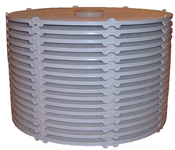The filtration of pharmaceutical and biological fluids requires a complete understanding of the filtration media and process. Michael Sidebottom reviews recent developments in depth filtration made by Carlson Filtration
Depth filtration techniques are changing to suit demand for increasingly selective filtration performance by pharma manufacturers. Solid/liquid separation specialist Carlson Filtration has just completed an 18-month development programme concentrating on two main areas:
• Continuing research into the adsorptive properties of different grades of activated carbon that is incorporated into the CarlCarb range of depth filter sheets. The carbon constituent removes colour bodies, colour precursors and other impurities from pharmaceutical intermediates and finished products.
• Development of filtration application data that can be used to predict the performance of different depth filter sheets in a range of applications.
Before looking at these developments in more detail, it is worth reviewing the different ways in which depth filtration sheets work (Figure 1):
Screening – physical screening or sieving at the depth filter sheet surface removes larger particulate matter (the larger orange particles).
Entrapment and Absorption – Finer particles are trapped within the depth filter sheet structure (the smaller orange particles).
Adsorption – Sub-micron particulate matter and ionic materials are selectively adsorbed by the electro-kinetic properties of the carbon source chosen for each application (the white particles).
Carlson’s review of selective filtration performance included examination of the adsorptive properties of activated carbons derived from different original base structures and sources, using three tracer impurities: iodine, methylene blue and molasses. These are widely used in the activated carbon industry and characterise the distribution of micro, meso and macro pores respectively, in turn measuring the adsorption capability for various molecular size contaminants.
The results of Carlson’s latest development programme predict the absorption rates and particle size ranges that can be removed by different base carbon structures (Table 1).
Besides the primary function of impurity removal by adsorption, there are three main customer requirements: obtaining the required purity; achieving maximum flow rates; and maximising filter sheet life. The main challenge is to find the optimum between these parameters for individual customers. Using this data, Carlson is able to advise pharma manufacturers how to select the most appropriate carbon type and filter sheet size and format for their application.
The applicability of the six activated carbon base structures to remove certain impurities is shown for both 12in and 16in lenticular depth filter module formats (Table 2). The weight of activated carbon in the module is shown in kg, along with the depth filter sheet surface area in square metres presented to the filtrate.
To cater for the wide variety of depth filtration applications and regimes used in the industry, Carlson offers its sheet range in numerous sizes and formats: a variety of individual depth filter sheet sizes from 20 x 20cm to 100 x 100cm are available to suit different filter presses. Alternatively the range is available in CarLent lenticular module format (Fig. 3).

Figure 3: 16 inch CarLent Filter Module
The CarLent lenticular module format is available in either 12 or 16in diameter modules and is ideally suited to filtration of high value products in short runs, such as pharmaceuticals and fine chemicals. Along with many manufacturers, Carlson has put considerable time and effort into the development of these modules to achieve an increased number of filter batch cycles before the module has to be replaced, with resulting lower product losses in the spent module.
The latest designs also provide the flexibility to accommodate a far greater range of different filter media; from lighter, thinner types right through to denser, harder grades, thus expanding the range of filtration applications.
The CarLent lenticular module design can be incorporated into a skid-mounted Lenticular Depth Filter System. Designed for convenient, clean and efficient depth filtration, this innovative system is a turnkey solution for most process filtration duties.
The skid-mounted system is supplied complete with filter housings, drip tray, pumps and valves. Traditionally, customers would have to design, source and install all these components and then hard-pipe them into their process. This is now taken in-house. The advanced design of the lenticular housing facilitates easy filter changes with minimal changeover times in the secure enclosed drip tray without the need for an additional bund wall.
| Application | Optimum Particle Size | |||
| Pharmaceutical | ICN | Light colours. Pyrogens. Odour | Medium | Small |
| PCN | General Colour | Medium | Large | |
| MCN | Vitamins. Antibiotics. Proteins | Medium | Large | |
| Chemical/General | ALN | Broad range/colour removal | Medium | Large |
| AN | Broad range/colour removal | Medium | Large | |
| ACN | Broad range/colour removal | Medium | Large | |
| 12in lenticular | 16in lenticular | 40cm sheet | 60cm sheet | |||||
| Kg carbon | M2 | Kg carbon | M2 | Kg carbon | M2 | Kg carbon | M2 | |
| ICN | 1.4 | 1.8 | 2.8 | 3.6 | 0.12 | 0.16 | 0.27 | 0.36 |
| PCN | 1.4 | 1.8 | 2.8 | 3.6 | 0.12 | 0.16 | 0.27 | 0.36 |
| MCN | 1.4 | 1.8 | 2.8 | 3.6 | 0.12 | 0.16 | 0.27 | 0.36 |
| ALN | 0.9 | 1.8 | 1.8 | 3.6 | 0.08 | 0.16 | 0.18 | 0.36 |
| AN | 1.08 | 1.8 | 2.16 | 3.6 | 0.1 | 0.16 | 0.23 | 0.36 |
| ACN | 1.4 | 1.8 | 2.8 | 3.6 | 0.12 | 0.16 | 0.27 | 0.36 |
